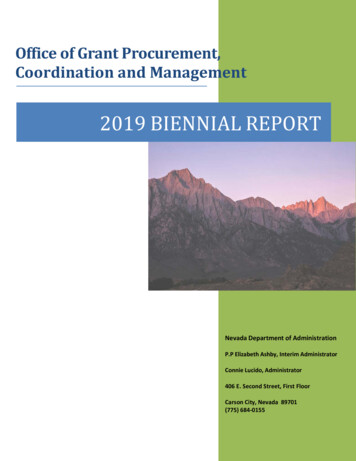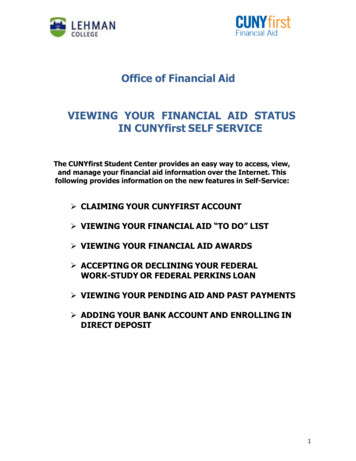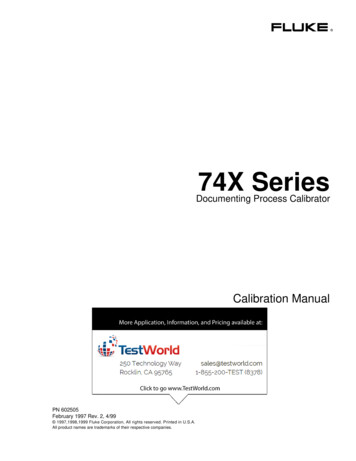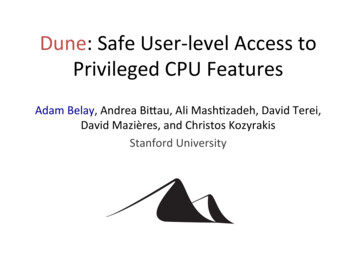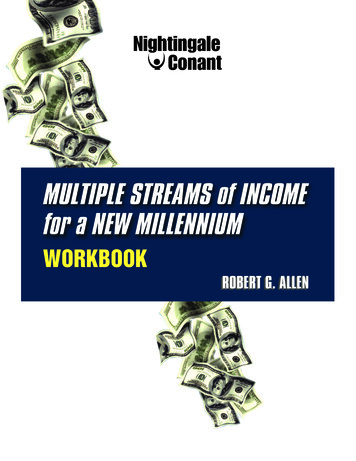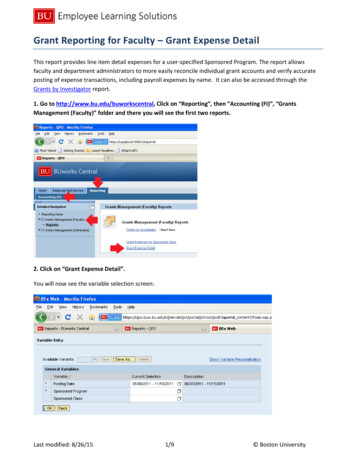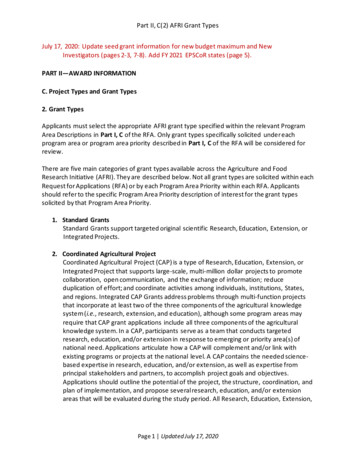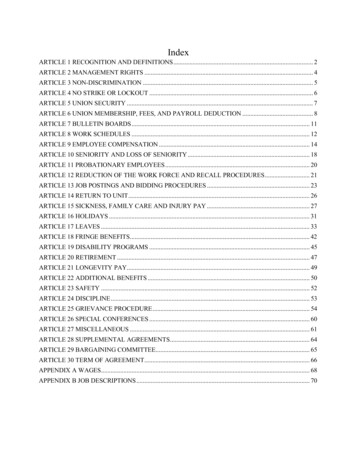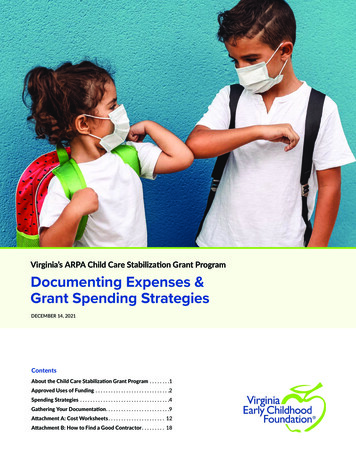
Transcription
Virginia’s ARPA Child Care Stabilization Grant ProgramDocumenting Expenses &Grant Spending StrategiesDECEMBER 14, 2021ContentsAbout the Child Care Stabilization Grant Program . . . . . . . .1Approved Uses of Funding . . . . . . . . . . . . . . . . . . . . . . . . . . . . .2Spending Strategies . . . . . . . . . . . . . . . . . . . . . . . . . . . . . . . . . . .4Gathering Your Documentation . . . . . . . . . . . . . . . . . . . . . . . . .9Attachment A: Cost Worksheets . . . . . . . . . . . . . . . . . . . . . . 12Attachment B: How to Find a Good Contractor . . . . . . . . . 18
About the Child Care Stabilization Grant ProgramVirginia received 488 million from the American RescuePlan Act (ARPA) to develop and implement a Child CareStabilization Grant Program. Virginia will distribute fundingto help child care businesses address the impacts ofCOVID-19, including the statewide staffing crisis. The fundswill allow child care providers to make strategic investments in their programs to strengthen their operationsand sustain services for our children and families that arefurthest from opportunity.Eligible providers will receive up to three payments ona quarterly basis to cover a 9-month period, September2021 through May 2022. Applications will be acceptedon a rolling basis, starting November 1, 2021, and will bereviewed each quarter until March 2022.AWARD SCHEDULEAWARDFirst QuarterSecond QuarterThird QuarterPERIOD COVEREDSeptember 2021 – November 2021December 2021 – February 2022March 2022 – May 2022This guide will help you to better understand what typesof expenses are considered allowable for coverage bythe stabilization grants, how to make sure you haveproper documentation of these expenses, and ideas forspending strategies that are allowable and provide ways tostrengthen your program both in the near- and long-term.The Virginia Department of Education (VDOE) will monitorproviders for compliance with the grant requirements. Allproviders are encouraged to maintain documentation ofexpenses with receipts, paid invoices or other documentation that shows how the funds were used and maintainthese on file for five years.Virginia’s ARPA Child Care Stabilization Grant Program: Documenting Expenses & Grant Spending Strategies1
Approved Uses of FundingHow can I use my funds?Calculating costs for Family Day HomesGenerally, grant funds can be used to support maintainingchild care business and program operations. Funds maybe used for allowable expenses incurred prior to thegrant period (i.e., you can reimburse yourself for allowable expenses that you already had prior to receiving thegrant). There is no time frame for spending grant funds.Understanding that the grant can cover past and futureexpenses, it is best to use the funds in accordance withwhat is allowable and will help you remain in operation.Family Day Home providers can use funds towards theabove listed allowable expenses. However, some expenseshave both a business use and personal use associated withthem (i.e., your monthly mortgage or rent for your home).For those expenses, family providers are encouraged to usethe Time/Space calculation to determine what percentageof those expenses can be considered business expenses.Here is a helpful worksheet that can guide you through thiscalculation. If you already have your time/space percentagecalculated from last year’s taxes, you can use that.While the list of specific expenses may vary depending onwhat is considered necessary for each individual operation,the following business-related costs are generally considered allowable for reimbursement under the StabilizationGrant: Payroll (including self-pay and owner’s draws for soleproprietorships) Staff benefits (including paid leave and supports to accessCOVID-19 vaccines, appointments and manage sideeffects) Employment and Personnel Costs (including bonuses,temporary or permanent increases in compensation,hazard pay) Rent (see below for calculating this for family day homes) Mortgage (see below for calculating this for family dayhomes) Utility Costs (see below for calculating this for family dayhomes) Property Taxes (see below for calculating this for familyday homes) Insurance (related to the business or employee benefits) Personal Protective Equipment (PPE)Why is a spending strategy important?Having a spending strategy is key to investing your grantfunds effectively and properly. While the investmentprovides an opportunity to sustain and strengthen yourbusiness, it also needs to be spent in compliance with thefunding requirements. It’s best to perform a brief needsassessment for your program, asking the following keyquestions:Investment Area 1: Financial Resiliency What past expenses do I have documentation for thatalso fall into the allowable spending categories for thegrant? What expenses have I put off because I could not affordto pay them? What are the main threats to my businesses’sustainability and how can I use these funds to mitigatethem? Am I prepared to respond to financial emergencies?Does my budget allow me to contribute to an emergencysavings fund? Cleaning Supplies Classroom Supplies Indoor and Outdoor equipment Business software and technology upgrades Office Supplies Transportation Minor repairs (construction and major renovations are notconsidered allowable) Food Staff development or training costs Mental health consultation services and supports forchildren and staffInvestment Area 2: Staffing Staffing is the engine that keeps the program running.How do I reward my staff so that my business cancontinue to operate? How can I provide ways help staff continue theireducation or receive training?Investment Area 3: Enrollment Am I having difficulty maintaining or boosting enrollmentat my program? How can I use these funds to supportmarketing efforts?Virginia’s ARPA Child Care Stabilization Grant Program: Documenting Expenses & Grant Spending Strategies2
Investment Area 4: Facility Improvements,Technology, or Equipment Do I need to make minor improvements to my Home orCenter? Do I need to make minor improvements to my playgroundor outdoor area? Am I prepared to carry out an emergency disaster plan?(If you are on a corrective action plan with the Office ofChild Care Health and Safety, think about whether youcan incorporate additional resources to help you come intocompliance on key health and safety standards.)Once you’ve answered these questions, you may have agood idea of how you wish to allocate your grant funds. Toinsert your responses to these questions and guide yourstrategy, we have provided a simple worksheet, DevelopingYour Spending Strategy .The next section of this guide will provide you with theactions to consider to execute your strategy. Are there pieces of equipment or technology that wouldimprove my program operations?Virginia’s ARPA Child Care Stabilization Grant Program: Documenting Expenses & Grant Spending Strategies3
Spending StrategiesInvestment Area 1: Financial ResiliencyDo you need to make up for lost revenue?The financial impact of the pandemic on child care businesses cannot be understated. Many programs havegrappled with closures, decreased enrollment and inconsistent attendance rates which contributed to a significantloss in revenue. Many child care business owners took outloans, dipped into savings, and paused paying themselvesto manage. Grant funds can support your recovery fromthose losses and help restore wages.Many businesses took on debt to survive the pandemic.Regardless of the source of the debt – the Small BusinessAdministration’s Economic Injury Disaster Loan (EIDL), orother commercial debt - accumulated debt makes it significantly harder for your business to recover. Typically, yourmonthly debt payments consist of a percentage of yourremaining loan principal balance. The higher this balance,the higher the interest you pay each month. Prioritizingpaying down this debt is a sound strategy that will help youcontinue to serve families and reposition your business’sability to make a profit by reducing your monthly costs. Thisstrategy will help free up revenue to use on other necessary expenses your program needs to operate.In addition to paying down debt, funds can be used to keepup with other routine payments while you get back onyour feet. For example, if you are having trouble affordingregular expenses such as utilities or home payments (mortgage or rent), you may be able to use these funds to keepoperations going until conditions have stabilized for you.Are you prepared for financial emergencies?Certainly, the pandemic has driven up costs of existingexpenses, created new expenses, and has contributed toless income for you. This makes budgeting for your newreality a key feature of your plan for continued operations.Not planning or accounting for these new expenses, andupcoming emergencies, could put your business in jeopardyof permanent closure.A monthly budget may be a good place to start for a smalleroperation, like a home-based child care. Once you’recomfortable with the process of budgeting, a six-monthcash flow may be the next level option for trackingincoming and outgoing funds.Once you have an idea of what your budget will allow, youshould consider putting aside funds for a rainy day. It’srecommended that businesses have three months’ worth ofexpenses available in an emergency fund, so that you cancontinue to meet your routine bills during times of financialchallenges.Do you have the systems in place to manage yourfinancial and other recordkeeping responsibilities?Having a defined way of tracking your revenue andexpenses will make it easier to follow through with yourdecision to follow a budget. Having accurate information toinform your budget will strengthen your ability to bounceback. Many providers can track their finances with a basicbookkeeping system and a business bank account. Initially,this tracking can be as simple as having a method to logweekly revenues from tuition and payments, the expensesthat you’ve had to pay, and store records of those transactions, or receipts.Once you have those business basics down, you mayconsider the use of electronic systems to track these withmore ease. Online systems such FreshBooks, QuickBooks,and Gusto can help with bookkeeping and payroll. Thesesystems can give you real-time information on your financial outlook and help you make necessary decisions. Thesesystems will also aid you during tax time, so that you areable to complete an accurate tax return.Keeping good records is essential to managing your business in general. In addition to the standard accountingtools we mentioned, you need to track child and staff data,attendance rates, meals and more. Be sure to also considerchild care management systems (CCMS) for these needs.Systems such as Brightwheel, Wonderschool, Procare, orEZCare can help with billing, attendance, etc.Family child care homes and small centers serving fewerthan 50 children can access free resources by sending aquick text. Text “Wonder” to 474747 to learn about a freesubscription to Wonderschool, an online software thatassists with your payables, enrollment, and marketing, andincludes an app for communications with families. For moreinformation or to join the 100 Virginia providers alreadyparticipating, text “Wonder” to 474747.For more information on the benefits of a CCMS, check outFrequently Asked Questions .Virginia’s ARPA Child Care Stabilization Grant Program: Documenting Expenses & Grant Spending Strategies4
Investment Area 2: StaffingAre you having difficulty maintainingstaff, recruiting new staff or lookingfor ways to reward your staff?A staple feature of the Child Care Stabilization GrantProgram is that the funds can be used to meet the pressingchallenges that the staffing crisis has presented. Now morethan ever, staffing is an integral component of the child carebusiness model. Without the necessary staffing in place,other components of the business’s ability to operate areat risk. Using grant funds for temporary pay increases andbonuses is a great way to push much needed funding intothe child care labor force and reward your hard-workingemployees.Finding ways to increase staff retention may requiremultiple approaches. There could be some quick actionsthat you can implement to aid in retention such as offeringa bonus or a temporary pay differential, pay substitutes togive your staff some additional time off, and other ways toacknowledge and reward staff. There are also longer-termapproaches such as increasing your pay scale, staff benefitsand paid time off, and supporting staff career development.Most of these strategies will have budget implications; itis advised that you plan for them in your budget to understand what you can afford.For more information on structuring and offering theseincentives, see How Can I Financially Reward My Staff?The same strategies can be applied in your pursuit ofattracting qualified staff. In a highly competitive employeemarket, you should consider using grant funds to offer asign-on bonus for new employees and offer employeereferral incentives to existing staff. The bonus can be structured in a way that aids in retention for your new staff, forexample a new staff member will receive their bonus aftersix months on the job with satisfactory performance.VDOE is committed to easingstaffing shortages and reducingturnover in child care programs. Programs that participate in the Child Care SubsidyProgram (CCSP) will receive a 20 percent addition totheir base ARPA Child Care Stabilization grant. Eligible educators in programs participating inthe PDG B-5 initiative will receive up to a 2,000Teacher Recognition Grant from VDOE.While compensation is likely the number one factor insomeone choosing to enter and stay in a job, benefits arealso a critical piece of their decision.There are many reasons why you should offer benefits, andhere are a few of them: Improved staff satisfaction which aids in increasedstaff retention. Happy and healthy employees are moreengaged employees! Makes the employer more competitive in a tight labormarket. This is what could separate you from anotherprogram offering similar pay. Lets staff know that they are valued and that you’resupportive of their needs.The pandemic has brought ondifferent needs and considerations for employees, andthey need a place of work that can meet those needs.Providing benefits does not have to be an all or nothingconcept. There are different benefits that can be offered,with varying price points (some may be little to no cost,some may be more significant). Even small increases canmake a big difference in a tight labor market. You may bewondering where to start and what your options are. Mostimportantly, you want to be sure that regardless of what isbeing offered, your employees are able to 1) see the valuein them and 2) easily understand them and 3) easily accessthem.While this is not a complete list, here are some of thecommon benefits that a company can offer employees: Paid Time Off (PTO) Health Insurance Retirement Supplemental Insurance (including Employee AssistancePrograms) Tuition Assistance and Staff Development Child CareTo learn more about these offerings, you can begin byresearching traditional insurance providers. You may findthat your existing payroll company or other online payrollservice providers like Gusto or Zenefits can provide youwith certain benefits. There are also Professional EmployerOrganizations and shared services networks and otherplatforms for collaboration such as your local chamberof commerce may offer other ways to provide benefitsfor your staff or discounts to do so. Outside of offeringcompany sponsored health insurance, you can still supportyour employees on an individual basis in accessing low costor free health insurance through the Affordable Care Actmarketplace. Ensure that employees are aware of whatthey may qualify for and facilitate a connection for them toVirginia’s ARPA Child Care Stabilization Grant Program: Documenting Expenses & Grant Spending Strategies5
work with a free Health Care Navigator who can walk themthrough their options. For more affordable health careoptions, click here .Do you pay yourself?As a staff person of the child care program, you can, andshould, pay yourself regularly. While this may be the lastthing on your mind when it comes to your list of expenses,it should not be neglected and should be treated as anyother payroll obligation.To determine how much you should pay yourself, youcould begin by drafting a monthly budget and tracking youractual revenue and expenses to understand how much youtypically take in and pay out in expenses for the month.This will allow you to see what a reasonable wage may be,noting that if you are a sole proprietor, your pay cannotexceed your revenue.Any payments to owners should be treated as you wouldany other regular payroll. If you receive pay as a W-2employee, then you would use the same documentation asyou would for any paid employee. You will need to recordpayments to yourself and having a business bank accountcan help you in this process. This will allow you to separate personal from business funds and help you track yourpayments.Would you like to continue educationor training for staff?Staff benefits range from pay to benefits that impact careersatisfaction. Providing opportunities to invest in your staffand advance their skills will benefit the quality of yourprogram while possibly aiding in the retention of qualifiedstaff. An investment in your staff can pave the way fornew art, music and reading programs, as well as new childlearning techniques. These programs can also make yourchild care business more appealing to families and helpstabilize enrollment over time.For Family Day Providers, scheduling time for professionaldevelopment can be a challenge. You could use the additional funds to cover the cost or expenses associated withthe time off or site closures for you to take professionaldevelopment days or pay for the additional staff coverageyou may need to attend trainings. Funds can also be usedto cover any staff travel expenses or per diems associatedwith professional development.Do you know Scholarships are available at no or low cost to earlyeducation professionals to take relevant courses atVirginia’s colleges and universities to improve theircompetencies and achieve credentials: VDOE administers a scholarship program forchild care providers. For more information, visitwww.vaccscholarship.com . VECF administers a scholarship program, ProjectPathfinders, designed to increase the skills of earlychildhood professionals in preschool and child caresettings. Early childhood education is one of the in-demandprofessions included to qualify for access to theG3 (Get a skill. Get a job. Get ahead.) initiative inVirginia’s community college system. See more atwww.virginiag3.com .In addition, early childhood education programs thatparticipate in the PDG B-5 and/or Unified VirginiaQuality Birth to Five System (VQB5) initiatives willalso have access to free, quality classroom and teacherresources. To learn more about these resources, visitVDOE’s webpage on building an early childhoodsystem.Investment Area 3: EnrollmentAre you having difficulty maintaining orboosting enrollment at your program?The pandemic has spotlighted the need for child carebusinesses to rethink their marketing efforts, tools, andstrategies to drive (or simply maintain) child enrollment. Typically, marketing efforts would be first expensecut from the already tight operating budget for mostprograms. However, now that securing enrollments ismore critical than ever, it is wise to consider using thisfunding to conduct marketing activities. This could consistof designing and purchasing promotional materials suchas fliers and brochures, starting or upgrading a programwebsite, upgrading signage, offering parent incentives toenroll, and purchasing paid ads.There are some no-cost activities that could be done tosupport your enrollment such as actively maintaining yourwaitlist and reaching out to those families as soon as youhave an opening.Virginia’s ARPA Child Care Stabilization Grant Program: Documenting Expenses & Grant Spending Strategies6
You may also find that a subscription to a shared servicesprogram, such as Wonderschool or the Virginia SharedServices Network, could assist in expanding your networkand offer marketing support, in addition to cost-savingsopportunities.Family child care homes and small centers serving fewerthan 50 children can access free resources by sending aquick text. Text “Wonder” to 474747 to learn about a freesubscription to Wonderschool, an online software thatassists with your payables, enrollment, and marketing, andincludes an app for communications with families. For moreinformation or to join the 100 Virginia providers alreadyparticipating, text “Wonder” to 474747.Investment Area 4: Facility Improvements,Technology, or EquipmentDo you need to make improvementsto your Home or Center?You may have a list of program quality or health andsafety improvements that need to happen to your facility.Investing in your facility can help you meet differentbusiness goals and aid in a better overall experience for thechildren and adults that occupy the facility. In addition tothe new health and safety needs that you may adapt for,grant funds can help you to finally address some of thosemuch-needed, long-term investments. Some strategiesinclude replacing your heating or cooling system, replacingyour roof or your gutters, providing new bathroom fixturesand toilets, or even revamping the kitchen for more efficient and sanitary service.Young children are very susceptible to their environments.It may be helpful to have a facility/home assessment doneto learn how to improve the environmental health of yourfacility such as air quality and water quality: Air quality improvement examples: HVAC upgrade,duct cleaning, humidifier, and/or portable air cleaners(purifiers). Providers can contact an HVAC specialist todetermine what can be done to improve air quality. Water quality improvement examples: replacing old,corroded pipes that may be subject to lead and coppercontamination. Providers can contact their local healthdepartment for water testing.Do you need to make playground oroutdoor area improvements?Another potential use for funds is to upgrade your playground and outdoor space for safety and quality purposes.Through these improvements, you can create an area thatwill be more developmentally appropriate and enjoy ablefor the children you serve.Outdoor play spaces are often a big factor for familieswhen choosing a program, so improved play space can alsopotentially impact your revenue by attracting new familiesas well as retaining the ones you have.Here are a few ideas to consider for upgrades to youroutdoor area: Play structures and equipment Rubber surfacing Pavement repairA note on facility improvementsJust remember that stabilization funds may not be usedfor capital investments (i.e., new construction or majorrenovations to your facility). If you are planning to do(or recently completed) a major renovation, make surethat your stabilization grant funds are put toward otherallowable expenses, such as rent or utilities, or wagesfor staff. Remember that your stabilization grant fundscan also be used to reimburse yourself for allowable expenses incurred in the past. The unrestrictedrevenue sources you originally used or would use forthese allowable expenses — such as parent tuitionpayments — can then cover costs associated withmajor capital expenses. Updated fencing Additional riding toys Outdoor toys to push and pull Tunnels or structures to crawl through Upgraded water or sand play areas Materials for an outdoor creative arts or STEM area Updated tricycles, balance bikes, helmets or scooters Natural play space materials Children’s garden Play tables Art station Additional outdoor seating or shaded areas for bookreading and outdoor lessons Awning for outdoor waiting areasNavigating a facility improvement project and finding agood contractor can be challenging, so we have includedsome tips in ATTACHMENT B .Virginia’s ARPA Child Care Stabilization Grant Program: Documenting Expenses & Grant Spending Strategies7
Are there other purchases, pieces ofequipment, or technology that wouldimprove your program operations? Updating the sign-in and check-out systems used byfamilies or caregivers (i.e., an electronic system that maywork with a child care operations system) Updating security systems or camera systems forclassrooms and common areas Improving technology equipment (i.e., iPads, laptops,printers/copiers, electronic filing, bookkeeping, tuition orfee payment systems or child care management systems) Purchasing a van or bus to facilitate transportation to andfrom school or other settingsYou can also consider adding other physical improvements,such as new laundry machines, replacing a refrigerator oran extra freezer, or any other kind of equipment that maymake things more efficient and effective for your program.Are you prepared to carry out anemergency disaster plan?While most programs are required to have emergencypreparedness plans, have you thought about whether youhave the necessary resources, equipment, and materials toeffectively carry out your emergency plan?Here are a few ideas to consider in executing your riskmanagement plan: Establishing or contributing to an emergency fund tocover expenses associated with emergencies, such asinsurance deductibles; Emergency supplies, including portable kits forevacuations and 72-hour supply kits for sheltering inplace; and Text messaging services/parent communication apps tobe used for emergency notifications.With the added sanitation demands of the pandemic, youcan also add equipment like: Portable sinks; Hand sanitizer dispensers; Touchless faucets and soap dispensers; HVAC or ultraviolet air purifiers to improve indoor airquality; Automatic door opener and flusher toilet; Touch-free waste bin; Steam cleaner vacuum; Childcare waiting area with wall dividers; Tables with clear tabletop dividers or individual studentdesks; Replacement classroom carpets or flooring; Dishwasher; and Upgrade sanitizer systems for cleaning toys and othermaterials in the center.Virginia’s ARPA Child Care Stabilization Grant Program: Documenting Expenses & Grant Spending Strategies8
Gathering Your DocumentationWhat do I need documentation for?you purchased. Generally, allowable expenses must benecessary to maintain or resume operations. Assemble information about the following common business expenses foreach month:Grant funds are provided up front, so you don’t have todemonstrate need to submit documentation showingthat you’ve already incurred expenses in order to applyfor a Child Care Stabilization Grant or receive payments.However, VDOE will conduct random monitoring to ensurecompliance with grant conditions and approved expenses.Whether you think you will be monitored or not, we highlyrecommend keeping record of and compiling documentation of your expenses along the way. This way, you will haveyour records in one place and will be ready to respond toany request for monitoring of these funds. Rent, Mortgage, Property Taxes, and Insurance: Theactual amount you paid for mortgage or rent, insurance,and property taxes. (Family day home providers can cover aportion for business use).To keep records of your expenses, you could create adigital file and save or scan them there or get a large manilaenvelope ready for your receipts. It is very important thatyou hold onto them for five years, so you will want tohave a way to keep the receipts safe until you need them.Programs using a Child Care Management (CCMS) systemsuch as Wonderschool, can use those platforms to easilystore and track their receipts and expenses. Payroll, Employment & Personnel Costs: This includesthose for W-2 employees, including yourself, andemployer payments for benefits (i.e., retirement andhealthcare).How do I make sure I have everything I needif I am randomly selected for monitoring?The Child Care Stabilization Grant Program offers financialrelief to child care providers across the state to supportstrategic rebuilding investments and help with expensesincurred because of the pandemic. Gathering informationabout expenses and documenting grant spending can seemdaunting but breaking down the steps can help make theprocess more manageable.Step 1:Figure Out Previous Pandemic-Related ExpensesFirst, go month by month through your recent records toreview: Receipts you have already collected Your credit card bills App-based system payments (such as Venmo, Zelle,PayPal, and Square Cash) Bank statements and canceled checks Third-party payroll systems (like ADP, Gusto, or Paychex)Collect proof of payment for every cost you want to coverwith the grant funds, such as a receipt, or an invoice marked“paid.” Unless the purpose is clear (such as a payment to thelocal electric company), you will need to show exactly what Utility Costs: The actual amount you paid for utilities(must be clearly for business use), including gas,electricity, telephone, and internet. (Family day homeproviders will need to use the Time/Space Calculation forutilities like gas and electricity to determine how muchqualifies as business use). If you are a sole proprietor paying yourself, youneed proof of payment like a payroll report orpay-by-check, bank transfer, or app paymentdocumenting in the memo that this was payroll for agiven period, and (2) it does not exceed revenue forthe same period. For example, if you took in 1,000for the month in revenue, you could not claimpayroll of 1,500. Contractors (o
Virginia's ARPA Child Care Stabilization Grant Program Documenting Expenses & Grant Spending Strategies DECEMBER 14, 2021 . good idea of how you wish to allocate your grant funds. To insert your responses to these questions and guide your strategy, we have provided a simple worksheet, Developing
